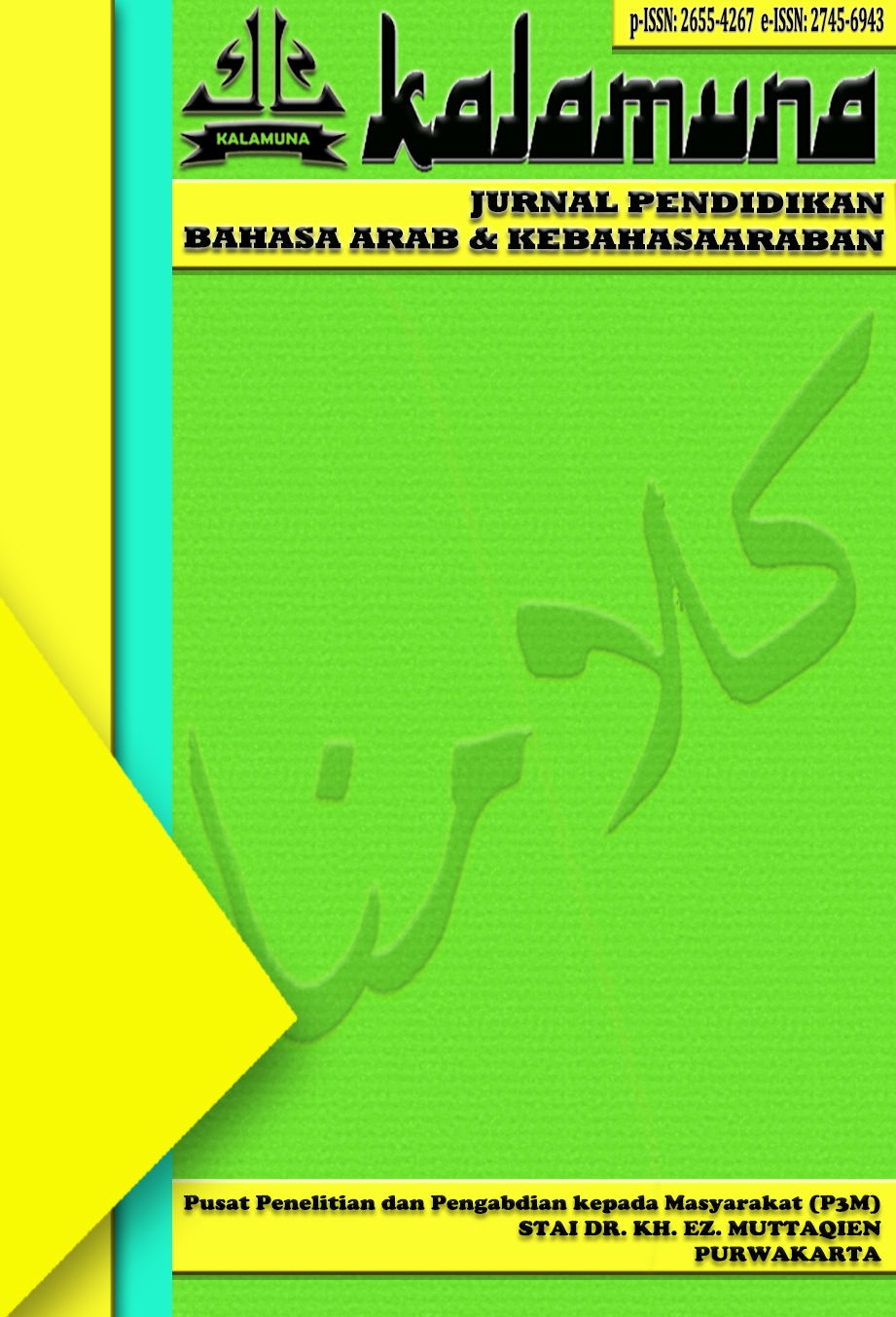Penggunaan Metode Dialog (Muhawaroh) dalam Keterampilan Berbicara Bahasa Arab Kelas VII di MTs Daarul Ma’arif Purwakarta
Keywords:
Dialogue Method, Speaking skills, ArabicAbstract
This study discusses several things regarding: 1) the use of the dialogue method (muhawaroh) in speaking Arabic at MTs Daarul Ma'arif, 2) the advantages and disadvantages of using the dialogue method (muhawaroh) in speaking Arabic at MTs Daarul Ma'arif. This study uses descriptive qualitative research with data collection methods by conducting interviews, observations, and documentation. After the data is collected, then data analysis is carried out using the theory of John Creswell. The results of the research obtained are learning using the muhawaroh dialogue method is more effective than other methods. Because by using this method, students look more active and interactive and also enthusiastic in learning what is conveyed. Teachers of Arabic subjects have been trying to improve the mastery of dialogue in Arabic in learning activities, the teacher always repeats the material that has been taught. This method is carried out by the teacher having a dialogue with his students on the hiwar material so that the overall mastery of Arabic dialogue in the learning process can be achieved so that students are skilled in speaking Arabic. The advantage of this method is to increase students' enthusiasm and interest in learning, with this method students can practice the conversation ahead and students don't feel nervous anymore. The drawback of this metkhod is, for some students the Arabic dialogue seems scary, for fear of pronouncing it wrong.
References
Abdul Hamid, O. H., & Dosen Fakultas Tarbiyah dan Keguruan IAIN Raden Intan Lampung, Ma. (n.d.). Teknik Pengajaran Bunyi Bahasa Arab.
Brunei. Kolej Universiti Perguruan Ugama Seri Begawan. (2012). Prosiding Seminar Antarabangsa Perguruan dan Pendidikan Islam (SEAPPI 2012) yang berlangsung pada 8-9 Mac 2012 di Johor Bahru. Pusat Penerbitan, Kolej Universiti Perguruan Ugama Seri Begawan.
CIA World Factbook (ISSN 1553-8133). (2018). The world factbook. CIA World Factbook.
iqd. (1324). majmu’atu rosail.
Lundeto, A. (2009). ANALISIS METODE PENGAJARAN FONETIK DAN MORFOLOGI BAHASA ARAB. In Jurnal Iqra (Vol. 3, Issue 1).
Faridah, S. N., & Fajar, A. (2022). Peningkatan Hafalan Mufradat Bahasa Arab dengan Metode Bernyanyi pada Santri di Pondok Pesantren Fajrul Islam Karang Hegar Subang. Satwika: Jurnal Pengabdian Kepada Masyarakat, 2(1), 29–40.
Luthfi, T., & Rijal Munir, D. (2021). Hubungan Mata Pelajaran Muatan Lokal Bahasa Arab Terhadap Kemampuan Baca Tulis Al-Quran Pada Siswa Kelas IX (Sembilan) SMP Al-Ihsan. Kalamuna: Jurnal Pendidikan Bahasa Arab Dan Kebahasaaraban, 2(2 SE-Articles), 172–185. https://doi.org/10.52593/klm.02.2.05
Mahyudin, E. (2014). MODEL PEMBELAJARAN DISKOVERI SEBAGAI STRATEGI PEMBELAJARAN BAHASA ARAB*.
Mujaddid, A. (2020). Penggunaan Metode Dialog (Muhawaroh) Dalam Keterampilan Berbicara Bahasa Arab Kelas X (Sepuluh) SMK Negeri 7 Mataram. IJERT: Indonesian Journal of Education Research and Technology, 2(1), 12–21.
Phillip. K. Hitti. (2006). History of the Arabs.
Syamaun. (2020). , “Pembelajaran Maharah Al-Kalam Untuk Meningkatan Keterampilan Berbicara Mahasiswa Program Studi Pendidikan Bahasa Arab Fakultas Tarbiyah Dan Keguruan UIN Ar-Raniry Banda Aceh.†. 11–12.
Walfajri. (2018). LANDASAN PENGEMBANGAN KURIKULUM BAHASA ARAB (Vol. 20, Issue 01).













